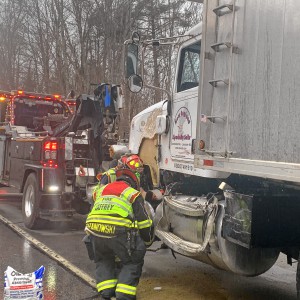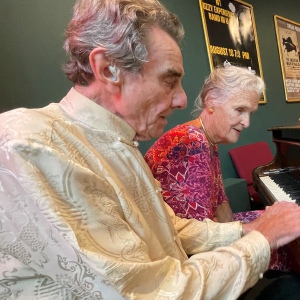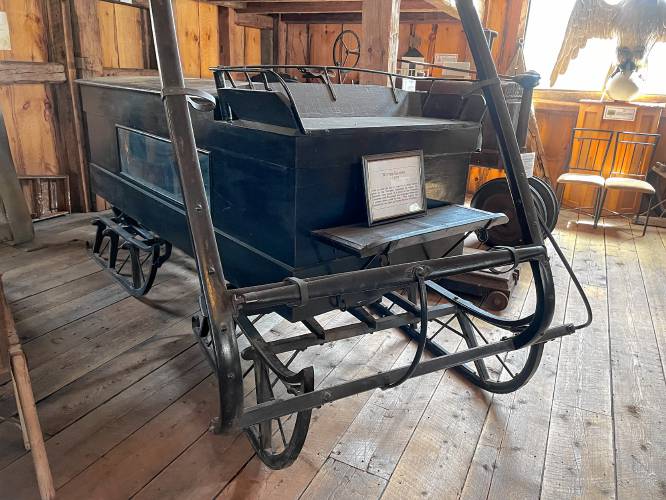The Greenfield Beat: Jesseca Timmons – Pobst pens the latest chapter of Francestown history
| Published: 04-12-2024 8:47 AM |
A few weeks ago, I had the pleasure of the covering the dinner honoring the women of Francestown, where I met quite a few of Francestown’s many active and enthusiastic community volunteers.
Among them was Kevin Pobst, author of the third volume of Francestown history, “Francestown: Fifty Years of Growth and Change, 1970-2020.” Pobst, a former high school principal and history teacher, said he moved to Francestown in 2014, and “wanted to know where he has moving to.” Pobst joined the Francestown Improvement and Historical Society (FIHS) and began to study the history of his new community. What Pobst learned, and what I discovered in my recent visit, is that Francestown is a town that deeply values its history.
Not only are there three volumes of Francestown history – Pobst’s new book picks up where the previous volume left off, in 1970 – the town has two separate museums dedicated to its history. The Heritage Museum, which is also sometimes referred to as “the Vehicular Museum in the Thulander Building,” is a restored barn housing the collection of longtime town resident and unofficial mayor Alan Thulander.
Thulander and his family lived just across the street in the Woodbury Homestead, which is named for Francestown’s most-famous resident, Levi Woodbury, who was governor of New Hampshire from 1823 to 1824. Woodbury is also the only American to have served in all three branches of the government at both the state and the federal level.
Pobst tells the story of the Heritage Museum barn in his book. Thulander, who was determined to create a museum for the town housing his incredible historical collection of antique vehicles, machinery and farm and household items, heard about a barn in New Boston that was for sale for $1. Francestown’s volunteer fire department went and dismantled the barn, numbered all the pieces, and reassembled it just behind the Town Hall (formerly the Francestown Academy). The barn was dedicated in 2012, two years before Thulander passed away.
Bill MacAuley and Bobby Abbot were also instrumental in the creation of the museum. McAuley, the curator, publishes a monthly newsletter about the Heritage Museum. (To sign up, send email to wfm03043@comcast.net.)
The Heritage Museum, which is open every Friday afternoon in the summer months during the Francestown Community Market at the Town Hall horse sheds, has some truly remarkable items, including the beautifully restored 1849 Francestown-to-Greenfield stagecoach. McAuley explained that visitors from Boston used to take the train to Greenfield and travel an additional nine miles up Route 136 “to access the ‘restaurants, banks and shops in Francestown.’” The Heritage Museum also has a pair of antique hearses – one of them on sleighs for winter use – and Francestown’s first fire engine, the “Mt. Crotchet.”
Meanwhile, the collection of the FIHS was housed in a few different places over the years, including on the second floor of the Bixby Library and in the small building off the common that is now the police station. In 2017, at the 100th anniversary of the FIHS, the building known as the Beehive was dedicated as the Francestown Historical Museum, and now houses the FIHS’ complete collection of artifacts and historical papers.
Article continues after...
Yesterday's Most Read Articles
 UPDATE: Drivers identified in Jaffrey dump truck crash
UPDATE: Drivers identified in Jaffrey dump truck crash
 Scott Bakula starring in Peterborough Players’ ‘Man of La Mancha’
Scott Bakula starring in Peterborough Players’ ‘Man of La Mancha’
 Fassett Farm Nursery in Jaffrey focuses on native plants
Fassett Farm Nursery in Jaffrey focuses on native plants
 Former home of The Folkway in Peterborough is on the market
Former home of The Folkway in Peterborough is on the market
 Bernie Watson of Bernie & Louise dies at 80
Bernie Watson of Bernie & Louise dies at 80
Pobst explained how the Beehive got its name, and it has nothing to do with bees. In the 1800s, Francestown Academy was a well-known preparatory school, attended by New Hampshire luminaries such Franklin Pierce and of course, Levi Woodbury. While most of the boys were housed with local families, a number of them lived in the little Cape-style house just south of the academy. The house was partitioned off into smaller rooms for the boys, and town residents said the house was “as busy as a beehive.”
The FIHS collection contains art, domestic items, books, papers and an exhibit on the soapstone industry which powered Francestown’s economy for many years. Pobst notes that British Railways used to provide travelers with soapstone feet heaters from Francestown’s quarry.er
Before Francestown’s 250th anniversary in 2020, Priscilla Putnam Martin, who Pobst makes clear is the “head tour guide” of the Historical Museum, asked Pobst if he would consider writing the third volume of Francestown’s history. The new history would take up where “Frances' Town : A History of Francestown” by John R. Schott left off, in 1970. Schott had continued the original history, “History of Francestown, N. H. from its earliest settlement, April 1758 to January 1, 1891, with a brief genealogical record of all the Francestown families,” by the Rev. W. R. Cochrane and George K. Wood.
“Cochrane and Wood wrote the genealogy of every family in Francestown. It’s pretty remarkable,” Pobst says.
In the course of writing “Francestown: Fifty Years of Growth and Change,” Pobst and a team of volunteer researchers, including Francestown teens, interviewed more than 50 town residents.
“In a small town like this, history is personal,” Pobst says. “It is all about relationships, celebrations, losses and the things that bring people together. I think the theme of the book is individuals do matter. They change the course of history.”
To learn more about Francestown’s museums, go to francestownhistory.info or francestownnh.org/heritage-museum. To order a copy of “Francestown: Fifty Years of Growth and Change,” search for it on Amazon.










 High Mowing School in Wilton holds May Day Festival
High Mowing School in Wilton holds May Day Festival New Ipswich firefighters called on to rescue horse
New Ipswich firefighters called on to rescue horse PHOTOS: A night at the sock hop in New Ipswich
PHOTOS: A night at the sock hop in New Ipswich
